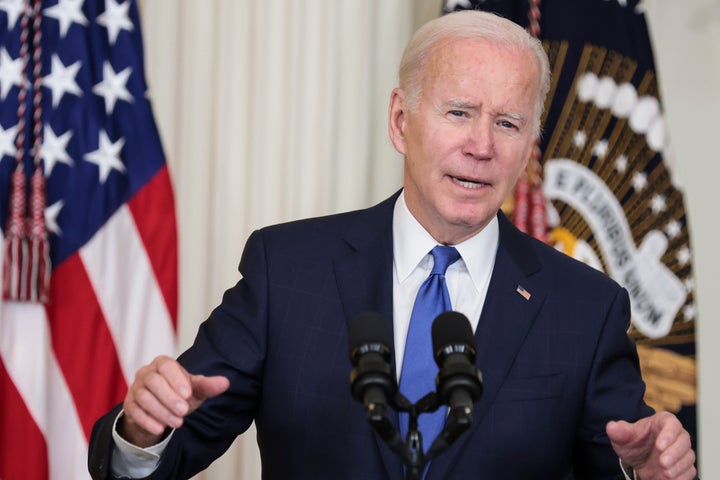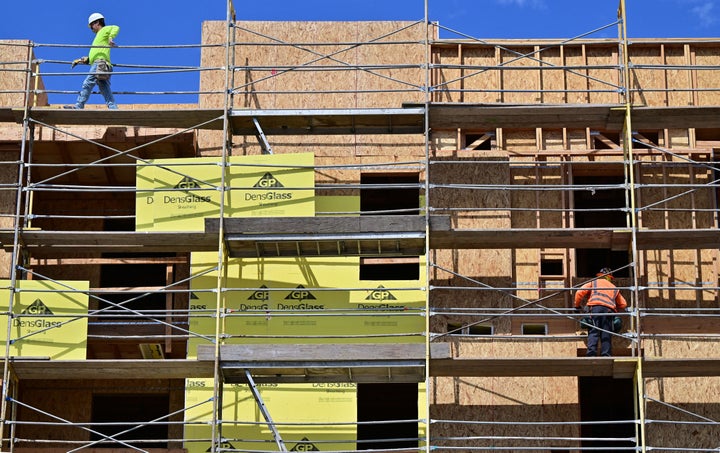The White House is required by law to move forward on a minor regulatory update that could have enormous consequences, spurring construction of tens of thousands of new homes built to the nation’s greenest energy efficiency standards ever written.
Yet more than a year after the key federal agency in charge said it would complete the initial steps to advance the rule, the Biden administration has yet to release a draft of the policy to the public ― a move that appeared to both violate the law and allow construction of as many as 20,000 new homes every month that will likely need costly upgrades in the future.
If enacted, the policy would save mostly low- and middle-income homeowners thousands of dollars in heating and cooling bills at a time when energy prices are soaring, inflation continues to sting, and the country’s aging electrical grids are buckling as Americans blast air conditioners to survive increasingly extreme heat waves. Over time, the highly efficient housing stock would, by one estimate, avoid up to 300 million metric tons of planet-heating carbon dioxide emissions ― nearly equivalent to the entire annual emissions of notoriously coal-addicted Poland.
But the proposal is lingering on an ever-growing bureaucratic docket. And no one seems to know why.
“This is the low-hanging fruit of climate policy,” said Lowell Ungar, the federal policy lead at the American Council for an Energy-Efficient Economy, the advocacy group whose researchers calculated the number of homes and quantity of emissions that the policy would affect.
“This is a way the administration can help lower-income families and help the climate at the same time,” he added. “And it’s just by following the law ― not something novel or really difficult.”
It’s not hard to see how a rule about which energy-saving building codes a newly built house or apartment must meet to qualify for federal housing loans fails to generate excitement or political pressure.
Boring as it may sound, it’s hugely important. The United States’ nearly 111 million buildings use roughly half the country’s energy ― and on average waste upward of 30% of what they consume annually. Combining direct emissions from oil furnaces and gas stovetops with the fossil-fueled electricity powering refrigerators, televisions and neon storefront signs, buildings produce more than one-third of the country’s greenhouse gasses.
Retrofitting older buildings with more insulation, new windows and electric appliances can be complicated and expensive. That means every new home and office constructed today to outdated efficiency standards, or without the circuitry for electric heating and cooking, only digs the world’s No. 2 emitter into a deeper carbon hole that will cost more to climb out of.
None of that is news to this administration. Just two months after President Joe Biden took office, the White House publicly warned industry groups against blocking the shift away from gas-guzzling buildings. The Democrat’s landmark climate-spending law earmarked millions to help states and cities adopt the most recent energy codes. The administration even vowed in December to “lead by example” by setting “a new gold standard” for slashing the energy use of renovated or new federally-owned buildings.

“Overall, the Biden administration has been so good about building codes, they really understand you can’t solve the climate crisis without really aggressively addressing buildings,” said Ben Evans, the federal legislative director at the nonprofit U.S. Green Building Council. “This seems like a no-brainer. That’s why this delay continues to be really curious.”
An administration spokesperson declined to comment.
At issue are the federal loans that help finance roughly one-fifth of all new home purchases every month. Primarily doled out via the Department of Housing and Urban Development’s (HUD) Federal Housing Administration, the loans require new homes be constructed to certain energy-saving standards to qualify.
The federal government does not set building codes in the U.S. ― that falls to states and cities. To guarantee contractors and manufacturers some degree of consistency, all 50 states use codes developed by the International Code Council, known as the ICC. Every three years, the private nonprofit convenes everyone from local governments to environmentalists, homebuilders to gas utilities to review and update the model energy codes that dictate everything from air flow to insulation to electrical wiring.
It’s then up to states or municipalities to put the code on the books. The adoption rules vary by state. Some set statewide standards, while others allow cities and counties to go at their own pace. This can lead to stark discrepancies. While Idaho hasn’t updated its code beyond the standards designed nearly two decades ago, Illinois by law adopts the latest version of the ICC’s energy codes within a year of their release.
In 2007, Congress sought to raise the benchmark, passing a law that disqualified any new homes built below the ICC’s 2006 efficiency standards from receiving federal housing loans through HUD or the Department of Agriculture. The legislation ordered the federal agencies to write their own efficiency standards, but provided a fallback option: Promptly review the latest ICC codes each time they come out to determine whether implementing them would jack up housing prices or reduce the availability of new housing. If everything checked out, the agencies could adopt the latest ICC energy codes in lieu of a standard designed in-house. Either way, the point was to continually raise the national benchmark for loan programs.
The ICC has updated its energy codes four times since, but the administration has adopted them just once: In 2015, when the Obama administration hiked the requirement for HUD’s FHA loans to the 2009 code.

The law set deadlines for federal agencies to set their own standards, but the legal language was murkier on adopting the ICC codes as a stopgap ― making it difficult for advocacy groups to sue the administration for missing deadlines, a common tactic for forcing action from a federal agency. And pressing for an agency-written standard did not seem like the fastest route to cleaner buildings.
“It’s hard enough getting them just to adopt the model code,” Ungar said of the agencies. “They’ve been so far behind, advocates have been much more focused on that rather than what might be an even slower process” of writing new federal standards from scratch.
When President Donald Trump took office, the Republican administration simply removed the year “2009” from the federal certificates homebuilders must complete to qualify for the loans. The result was a confusing and effectively meaningless requirement that the new home needed to meet any ICC energy code standard.
As Trump tried rolling back even the most mundane efficiency standards and made the U.S. the only nation to withdraw from the global Paris climate accords, dozens of states and cities passed laws requiring them to zero out local emissions in the coming decades.
That created a problem. Counties, cities and towns have little power over automobiles and electrical plants, the country’s two biggest sources of emissions. Many of them did, however, have a say over what kinds of buildings are erected within their jurisdictions. And even those beholden to statewide rules could influence the model codes through the ICC.
While a wide range of professionals weighed in on writing the model codes each cycle, the final edition was put to a vote in which only government officials could cast ballots, lending democratic legitimacy to the private consortium’s codes.
For years, that system mostly maintained the status quo, offering up codes that improved energy efficiency by a paltry 1% at most each cycle. In 2019, however, local governments eager to cut emissions registered to vote in droves. Organized through climate-focused groups like the Michael Bloomberg-backed U.S. Conference of Mayors, the officials this time approved the most ambitious slate of codes in years. The final version of the codes set to take effect in 2021 raised the efficiency of new buildings by up to 14% and required builders to include the circuitry for electric appliances and vehicle chargers in all new homes, saving a future homeowner who wants an induction stove or a Tesla thousands in electrician costs down the road.
Industry groups balked at the changes, calling the election illegitimate and challenging dozens of government officials’ eligibility to vote. When that failed, trade associations including the National Association of Home Builders and the American Gas Association asked the ICC’s appeals board to overturn key provisions in the codes. The gas utilities’ appeals won, and the ICC struck the electrical wiring requirements.
Soon after, the ICC took the unexpected step of proposing to eliminate governments’ right to vote altogether. Municipalities would still vote on codes for things like swimming pools and plumbing, but the energy rules would instead be decided by “consensus”-oriented panels where industry would enjoy equal representation to local governments.
The proposal drew immediate backlash from governments, architects, green builders and efficiency advocates, who saw the move as a quiet coup by homebuilders and fossil fuel companies who already wielded disproportionate influence at the ICC.
“This is the low-hanging fruit of climate policy. This is a way the administration can help lower-income families and help the climate at the same time. And it’s just by following the law ― not something novel or really difficult.”
- Lowell Ungar, ACEEE
As a final decision loomed in February 2021, the newly-inaugurated Biden administration urged the ICC against scrapping a system that appeared to work appropriately and delivered clear economic and environmental benefits. Such a change could, the Energy Department warned, undermine the codes’ legitimacy.
The ICC countered that not enough states were voluntarily adopting the most recent codes, and insisted that the committee model would actually make it easier to take big leaps in energy efficiency that would have more popular support. That March, the ICC approved the changes.
Gas companies hailed the change as a victory. In an internal 2021 document from the American Public Gas Association, the trade group representing gas utilities told its board of directors the new ICC system “should be beneficial,” allowing for a “more balanced” code-writing process that would “ensure consumers have a choice in the energy they want in their home or business.”
Sure enough, when the newly-assembled committees at the ICC started writing the energy codes last year, a gas utility executive in Missouri secretly sent an email that nearly torpedoed a provision to mandate the wiring for electric vehicle charging, the lack of easy access to which has become a major problem over the past two years as sales of battery-powered cars surged. The issue ultimately resolved itself, but the incident seemed to confirm advocates’ fears that a commonsense climate policy that passed under the old system would not even make it past the draft phase in this new process.

With that in mind, more than a dozen advocacy groups sent a letter in June 2021 to HUD, urging the agency to quickly adopt the 2021 energy codes. Doing so would be a straightforward but lengthy bureaucratic process. HUD would need to make a “preliminary determination” that the new codes would not harm availability and affordability, and submit that draft to the White House Office of Management and Budget (OMB) for approval, a process that is supposed to take 90 days or less. Once approved, HUD would publish the draft, accept public comments for up to two months, review those remarks, then submit its final determination to OMB. The final version could be applied to all the paperwork required to get a housing loan, and a green building boom could begin.
If highly prioritized, the whole process could reasonably take a year. In July 2021, Kevin Bush, HUD’s deputy assistant secretary for grant programs, said in a letter that the agency expected to follow the law by publishing its draft determination for public comment “later this year.”
But HUD did not submit its draft to OMB until August 2022.
Eight months later, the as-yet-unpublished document remained unmoved from its spot on OMB’s public docket until Monday. OMB said in the docket that it completed its review on Friday ― a lengthy process that appears to have ended hours after HuffPost contacted the agency for comment.
Once finalized, that one determination will apply jointly to both HUD and USDA. The Department of Veteran Affairs is required by the same statute to follow an identical procedure. But Congress only passed that law last year, putting the agency on a different time frame. It’s unclear when the determination will be made public.
Even just releasing the draft documents would likely have an impact, said Kim Cheslak, director of codes for the nonprofit New Buildings Institute and a member of the new ICC committee writing commercial building codes.
A federal stamp of approval for the 2021 energy codes “gives more market momentum and says we know these things are achievable without increased cost,” she said. “It can really help the construction industry move forward as we need to move forward, and will have an immediate impact on thousands of homes.”
Asked why she thought the White House hadn’t done so, she replied: “Inertia.”
Then she sighed. “The reason I think they’re not doing it is inertia and political pressure,” she said. “The ICC experienced similar political pressure. These groups have huge lobbying interests and arms.”

